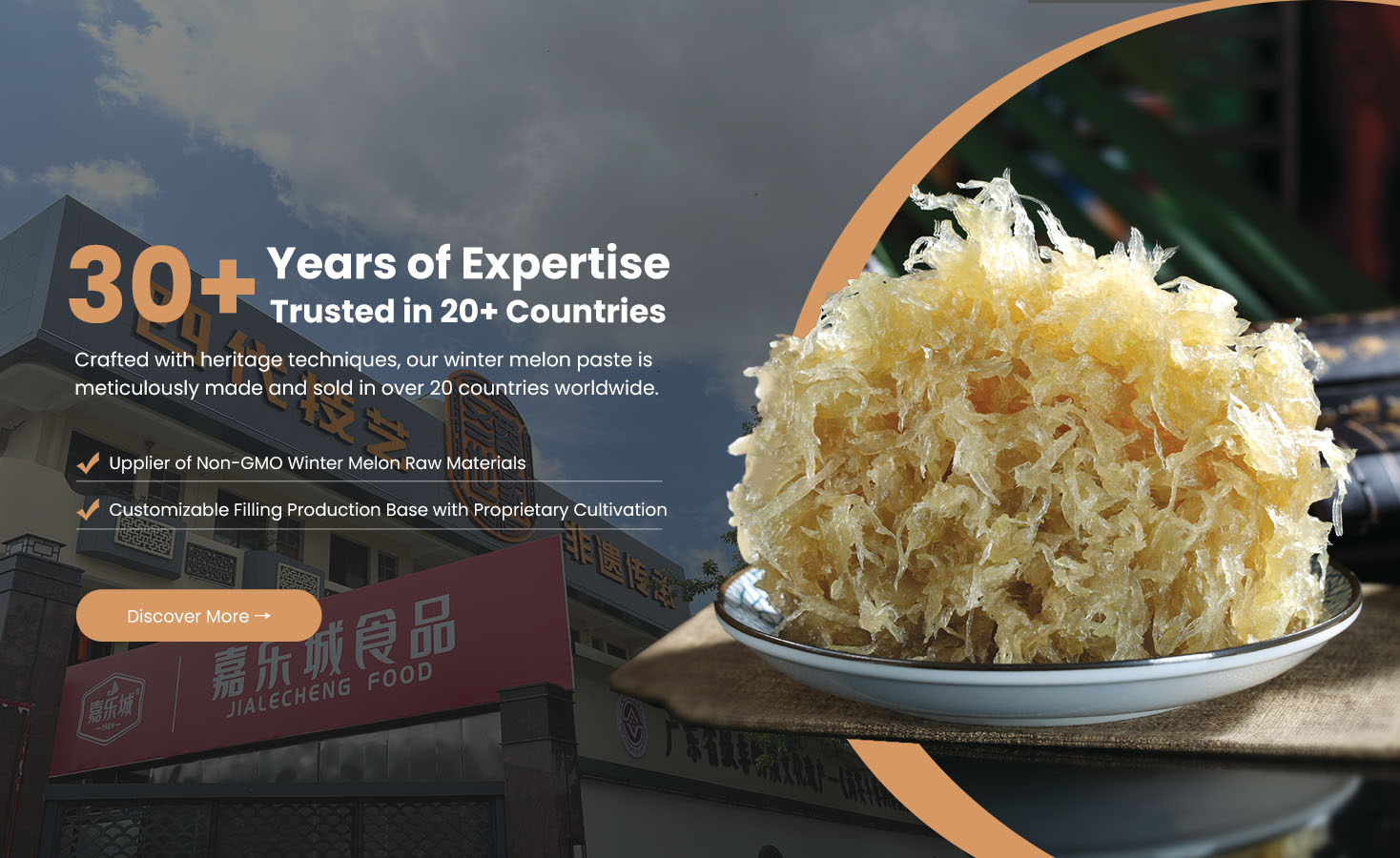How Does Jialecheng Ensure Consistency In Winter Melon Filling Quality?
Jialecheng Foods, founded in 1989 in Taishan City, Guangdong Province, is one of China’s leading producers of winter melon paste and sweet pastry fillings. With decades of experience, the company has refined its production system to combine traditional cooking craftsmanship with modern industrial control — ensuring that every batch of filling maintains the same taste, texture, and safety standards.
Consistency is the key to success for bakery manufacturers who rely on uniform quality across thousands of pastries. Below is a detailed look at how Jialecheng Foods achieves that through its integrated production process, ingredient control, and technology-driven quality management.
1. Farm-to-Factory Raw Material Control
Jialecheng operates its own winter melon cultivation bases under a “company + farmer” cooperation model. This system gives the company full traceability and control over its raw materials.
Quality assurance begins at the farm:
Strict seed selection: Only high-yield, low-fiber melon varieties are cultivated.
Standardized planting techniques: Farmers follow guidelines for soil, irrigation, and fertilizer use.
Harvest at optimal maturity: Melons are picked at the right sugar and water ratio for best paste yield.
On-site inspection: Every batch of melon is checked for appearance, texture, and freshness before processing.
| Step | Control Point | Benefit |
|---|---|---|
| Seed selection | Certified melon strains | Consistent texture and sweetness |
| Harvest management | Fixed maturity index | Uniform fiber content |
| Farm supervision | Regular field audits | Stable raw material supply |
| Pre-processing inspection | Visual and moisture tests | Eliminates low-quality melons |
This vertical integration ensures that only the freshest, uniform melons enter the production line — the first step in consistent filling quality.
2. Standardized Ingredient Formulation
Winter melon alone cannot guarantee consistency; precise ingredient ratios are equally important. Jialecheng follows fixed formulations based on years of R&D testing.
Typical composition control:
Winter melon: 55–60%
Sugar: 30–35%
Maltose or glucose syrup: 5–10%
Vegetable oil or shortening: 3–5%
All ingredients are weighed using digital load-cell scales to eliminate human error. Each recipe is stored in the company’s production management system (PMS), ensuring that operators follow exact specifications for sweetness, viscosity, and color.
| Ingredient | Measured Parameter | Purpose |
|---|---|---|
| Sugar | Brix value (sweetness level) | Controls texture and gloss |
| Maltose | Density test | Prevents crystallization |
| Oil | Quality and melting point | Ensures smooth mouthfeel |
| Winter melon | Moisture and fiber test | Determines paste firmness |
3. Controlled Cooking and Concentration Process
The cooking stage is where texture and gloss are defined — and Jialecheng uses automated vacuum cooking systems to guarantee uniform results.
Key technologies used:
Steam-jacketed vacuum cookers: Maintain consistent temperature (95–105°C) while preventing caramel burn.
Agitation control: Automatic paddles stir at fixed speed to avoid overcooking or uneven caramelization.
Digital sensors: Continuously monitor moisture evaporation and viscosity.
Batch recording: Each production run is logged with time, temperature, and sugar concentration data.
This ensures every batch reaches the same moisture content (18–22%) and Brix level, resulting in uniform density and sheen.
| Parameter | Target Range | Impact |
|---|---|---|
| Temperature | 95–105°C | Prevents flavor loss |
| Moisture | 18–22% | Stable texture |
| Sugar (Brix) | 68–72° | Balanced sweetness |
| Stirring speed | 30–40 rpm | Smooth consistency |
4. In-Line Quality Testing
Throughout production, Jialecheng performs in-line and post-batch quality inspections to maintain precision.
Tests include:
Moisture content (by infrared analyzer)
Viscosity and texture (using rotational rheometer)
Color uniformity (via colorimeter)
Microbiological checks (for hygiene and safety)
Each test result is stored in the company’s digital traceability database, linked to batch numbers for complete product tracking.
| Test | Equipment | Purpose |
|---|---|---|
| Moisture | Infrared moisture analyzer | Ensures paste is neither too dry nor too wet |
| Viscosity | Brookfield rheometer | Measures smoothness and flow |
| Color | Lab* colorimeter | Confirms golden consistency |
| Microbial count | Rapid agar plate method | Guarantees hygiene and shelf stability |
5. Hygiene and Safety Systems
Jialecheng maintains ISO9001, HACCP, and food safety certification, which require rigorous monitoring at every stage:
Stainless steel production lines to avoid contamination.
Filtered water systems for washing and cooking.
Closed-loop piping to prevent air or particle exposure.
Regular disinfection and environmental checks in processing zones.
Workers follow Good Manufacturing Practice (GMP) protocols — including clothing sanitization, temperature checks, and hand hygiene — to ensure clean and safe production.
6. Automated Packaging and Vacuum Sealing
After cooking and cooling, the paste is transferred through sealed pipelines to automatic weighing and vacuum packaging machines.
Each pack is sealed under low-oxygen conditions to preserve color and freshness.
Metal detectors and optical scanners inspect all packages before boxing.
The sealed paste maintains its texture and aroma for 6–12 months under proper storage.
| Step | Control System | Benefit |
|---|---|---|
| Weighing | Digital scale with ±0.5% tolerance | Precise packaging weight |
| Sealing | Full vacuum environment | Extended shelf life |
| Inspection | Optical and metal detection | Zero contamination guarantee |
7. Continuous R&D and Product Customization
To maintain consistency across markets, Jialecheng’s R&D team regularly adjusts product parameters based on customer requirements:
Sugar and moisture levels tailored for tropical or cold climates.
Flavor customization (coconut, sesame, pineapple, mango).
Low-sugar or fiber-enriched versions for health-oriented bakery lines.
Every new formula undergoes pilot-scale testing and stability trials before mass production, ensuring reliable performance for OEM and ODM clients.
8. Quality Traceability and After-Sales Support
Each production batch carries a unique traceability code that links:
Raw material origin
Production date and operator
Testing records
Shipment details
This system allows customers to verify quality data instantly and provides full accountability in case of inquiries. Jialecheng’s technical team also offers baking guidance and formulation adjustment to help clients maintain consistent results in their own pastry production lines.
9. Summary: The Jialecheng Consistency System
| Quality Factor | Control Method | Result |
|---|---|---|
| Raw materials | Own cultivation base | Stable sweetness and texture |
| Ingredient ratios | Digital formulation control | Uniform flavor |
| Cooking process | Vacuum temperature automation | Smooth, glossy paste |
| Testing | In-line and batch laboratory checks | Reliable quality data |
| Hygiene | HACCP + ISO9001 systems | Safe, export-grade filling |
| Packaging | Vacuum sealing with metal detection | Extended shelf life |
| Traceability | Digital batch coding | Full production transparency |
10. Conclusion
Jialecheng Foods ensures consistency in Winter Melon Filling quality through a fully integrated approach — from farm-level raw material management to digitalized cooking control and laboratory verification. This precision-driven process guarantees that every pack of winter melon paste maintains the same smooth texture, balanced sweetness, and golden gloss, batch after batch.
By merging traditional craftsmanship with industrial quality assurance, Jialecheng continues to deliver dependable, export-ready fillings that meet the exacting standards of professional bakers and food manufacturers worldwide.




